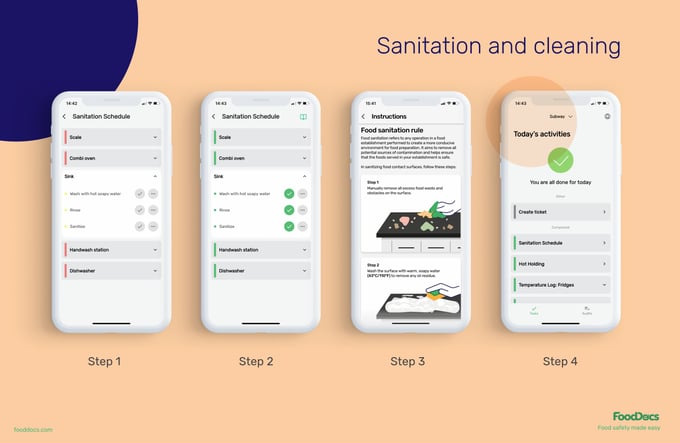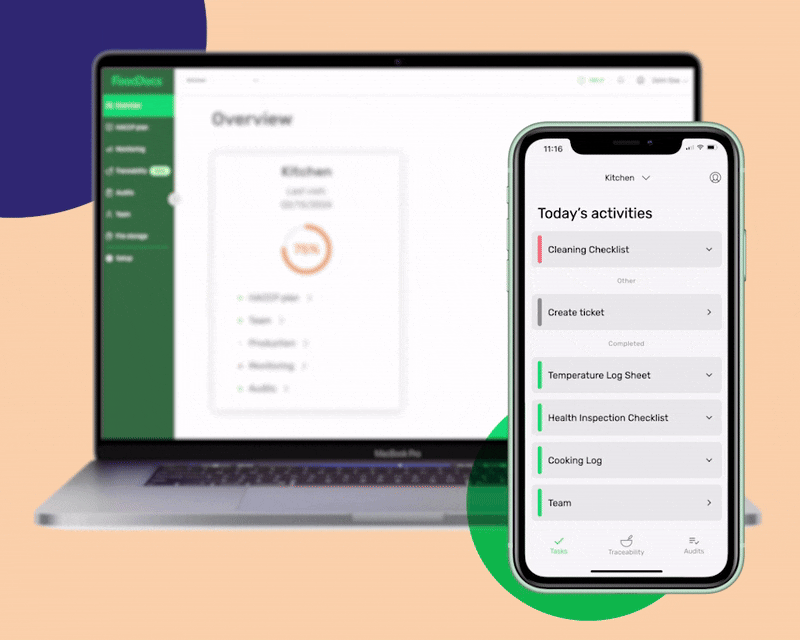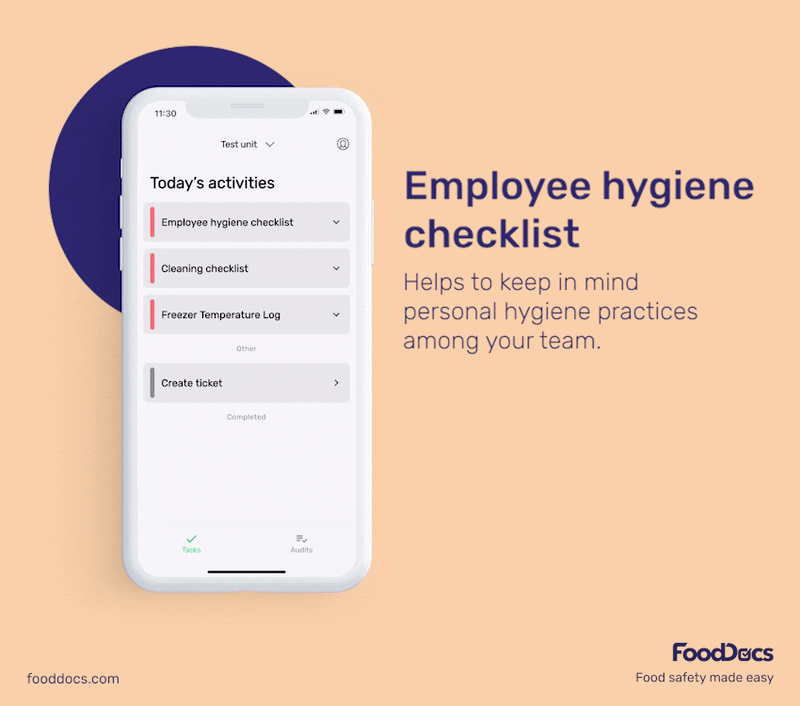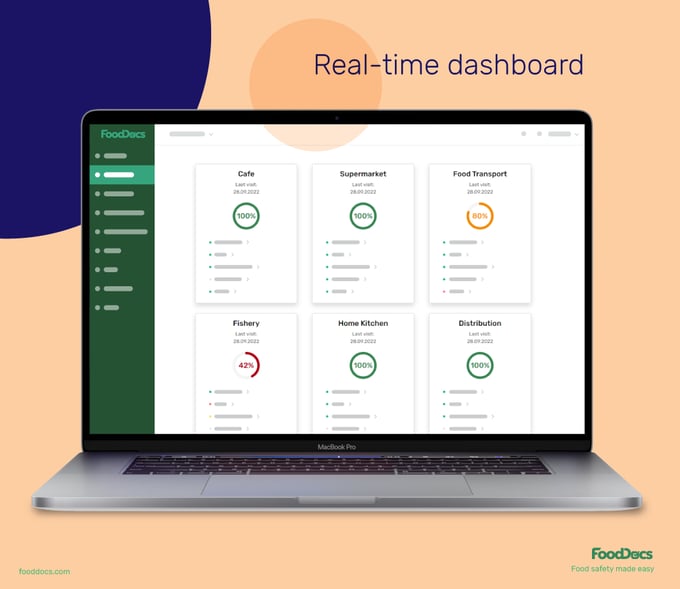Why Is Food Safety Important In Healthcare? Healthcare Leaders Guide
Learn challenges healthcare foodservice teams face today and key food safety practices to protect vulnerable patients. Get a free healthcare leader...
Keeping food safe, although often unnoticed, plays a big role in sustainability and the growth of every nation's economy. As such, it is the responsibility of every food handler to have the best approach to food safety. One of the key elements in this everyday objective is to know the common sources of food safety risks. Every food handler must understand what food contamination is.
In any food business, allowing contamination uncontrolled in the production area can lead to severe consequences.
WHAT WE'LL COVER:
The food contamination definition refers to the presence of unwanted materials or substances in food that may harm public health.
Contamination of food is a global concern that significantly affects all other industries.
The presence of unwanted substances in food can lead to foodborne illnesses and other related injuries depending on the type of food contaminant present. As members of the food industry, it is every food handler's responsibility to learn the best practices to control food contamination.
Food contamination can occur at any point in the food supply chain. Without proper preventive measures, certain points of the supply chain can easily be penetrated and cause a widespread foodborne illness outbreak.
The effects of food contamination cannot be underestimated. Some food contaminants can cause adverse health effects and even lead to death. As a food safety manager, you want all types of food contaminants outside of your preparation and delivery area.
Manage all food contaminants in your business using FoodDocs' smart Food Safety Management System. Get automatically generated digital monitoring logs and checklists that you can use for controlling contaminants. Ensure food safety compliance with our smart solutions.

A food contaminant refers to any substance that is present in food and can potentially cause harm to consumers.
Food contaminants may be biological, chemical, or physical in nature. They can be naturally occurring in the food material or introduced during food production, handling, or storage.
A food contaminant refers to an unwanted object in food, whereas food contamination is the event or presence of the object in food. Contaminants are major concerns in the food industry. They can cause food poisoning outbreaks and related injuries if not properly controlled.
Every food business is mandated to establish controls and monitoring procedures against food contaminants.
"Contaminated" is a term in the food industry used to refer to the state of food, whether raw material or finished product, being compromised by harmful substances.
A food object is referred to as contaminated if it comes in contact with an unwanted substance and could result in severe illness or injury if consumed.
Contamination can occur through various means, including biological, chemical, or physical sources, and it is a significant concern for food safety and quality assurance in the industry.
These types are the major categories of food contamination and do not include others, such as allergenic contamination and radiological contamination. Depending on the type of raw materials and products being produced, the most common food hazards in a business may vary.
Get to know more about the three types of food contamination and the most common food contamination examples under each category:
One of the most common types of contamination, biological contamination, refers to the presence of harmful microorganisms such as bacteria, molds, yeasts, viruses, and parasites.
These harmful agents are collectively known as food pathogens.
Depending on the biological hazards in food, their effects can range from mild problems such as nausea to life-threatening foodborne illnesses.
These pathogens are the top six microorganisms that cause foodborne illnesses in the US. Other pathogens such as Clostridium botulinum, Staphylococcus aureus, and Listeria are also top contenders in this category.
Biological contaminants or otherwise termed microbiological contaminants.
Every year, the effect of these pathogens accounts for at least 20% of the foodborne illnesses in the US.
These changes indicate food spoilage and that the food products are not safe for consumption anymore.
Although the effects of biological contamination can be severe, they can always be prevented and controlled.
Proper food safety practices and constant monitoring are key to controlling biological contaminants. With an effective food safety management system, the sources of these contaminants can be controlled and rooted out.
Some biological contaminants are naturally part of fresh produce, especially those that are grown from the soil and are exposed to environmental contaminations, such as root crops.
Other perishable foods, such as unpasteurized milk, milk products, raw sprouts, leafy greens, raw fish, and raw meat, are very nutritious, and they make a good growing medium for infectious organisms. They can cause health risks when not handled properly.
In addition, drinking water contaminants can be a very dangerous source of these biological contaminants. Contaminants can enter the food production system during the food preparation process through contaminated water when raw materials are washed.
This fact tells you that any food ingredient must be properly prepared and cooked to prevent disease-causing microorganisms from causing any damage or harm to consumers.

Chemical contamination refers to the presence of unwanted chemicals in foods that can compromise their safety.
The mentioned chemical contaminants can enter a food business at any point and contaminate foods. Chemical contaminants carry a great threat to the health of consumers. Their effects can vary depending on sources and concentrations.
While chemical contaminations occur less often than biological contamination, their potential to cause damage is significant.
Chemical substances may be introduced to the food being made through improper use and food handling.
The preparation of food also plays a great role when it comes to chemical contamination. For instance, improper washing of fresh produce can leave traces of fertilizers or pesticides that can find their way into other food products. The effects of these unwashed contaminants can worsen when exposed to heat and served to customers.
Additionally, by-products such as acrylamide can be used as an indication of temperature abuse. This substance is a harmful chemical that is considered a carcinogen.
Use FoodDocs' smart features to get clear and informative monitoring logs for controlling chemical contamination. Sanitizer Concentration Log and Cleaning and Sanitation Checklist help to minimize and control cases of chemical contamination in commercial food facilities.
Physical contamination is the presence of unwanted foreign materials in food. These foreign materials can cause injuries, bleeding, choking, and broken teeth when ingested.
At worst, physical hazards can block air passage and prevent normal breathing.
Natural physical contaminants are naturally part of food materials, such as fruit stems, whereas unnatural ones include stones, glass, and metal fragments.
Physical contaminants, depending on their size, can be detected through visual detection.
When undetected, physical contaminations can cause serious injuries to consumers. Some may cause injury, whereas others can create cuts to the throat or mouth.
Physical contaminants can come from food handlers and become transferred, such as fingernails or hair in food. In addition to causing injuries, these contaminants can become precursors to other types of contamination, such as biological contamination. Fingernails can introduce harmful organisms to food.
Such is also the case when it comes to physical contamination from pests. Foodborne pathogens and diseases can result if these contaminants are introduced into the food. This effect highlights the importance of pest management outside of the production area.
Cases of physical contamination can result in a widespread food recall in food manufacturers. In recent years, the presence of physical contaminants has topped the charts of food recalls. These contaminants were reportedly composed of hard and soft plastics, metal, rubber, and glass, which may originate from packaging materials and unmaintained equipment.

While these contaminants can easily go into the food being prepared, food handlers can prevent them with an effective food safety management system.
Proper preventive and control measures can be put in place to ensure that these contaminations are well monitored. Your best bet is to implement a digital Food Safety Management System (FSMS). At FoodDocs, we offer an intuitive solution to control the risk of food poisoning.
Using our smart Food Monitoring System, you can be sure that food safety practices are done effectively and on time. Common sources of food contamination can be addressed even before they can create any damage. With our monitoring tasks set at autofill, your kitchen staff can save time and promote the accuracy of recordings.
Additionally, our Food Safety System features detailed instructions on how to perform food safety tasks. With this feature, you can ensure that every employee will perform tasks exactly as instructed, ensuring food safety daily. You can also upload your versions of instructional materials to make training more personal for your business.

Switch to a digital FSMS now and significantly improve your monitoring system with FoodDocs. Implementing our digital system takes only 15 minutes, and you can try it for free for 14 days.
The main cause of food contamination is biological agents including pathogenic bacteria, viruses, molds, yeasts, and parasites.
Foodborne illnesses resulting from biological contaminants cause symptoms such as vomiting, diarrhea, and abdominal pain. When left untreated, they can become life-threatening.
One factor why biological contaminants are considered the main cause of food contamination is their ability to transfer from one place to another. Bacteria and other types of pathogens can easily be spread through cross-contamination.
Because pathogens are too tiny to be seen, food handlers who do not practice safe food handling can spread them from one point to another. By simply holding raw foods and then a piece of equipment or a clean utensil, the naturally present pathogens can spread.
You can learn more about how quickly bacterial contamination can occur from one of our articles.
The worst carrier of contamination in food service is a food handler who does not regularly wash his or her hands.
Learn more about how to avoid cross-contamination from occurring in your kitchen area from our informative article.
Ensure strict food hygiene in your food business with the help of our smart solutions at FoodDocs. Using our smart Food Safety Management System, you can get an automatically generated Employee Hygiene Checklist. Pair this checklist with our smart notification system to ensure every food worker will never forget any hygiene task.
The most common type of contaminant that can cause foodborne illness is biological contaminants, including harmful bacteria, viruses, parasites, and fungi. These pathogenic microorganisms can contaminate food during production, processing, or handling, and when consumed, they can lead to various foodborne disease outbreaks.
Microorganisms can be controlled through proper food-handling practices. Their number can be easily controlled with operations such as cooking properly, cleaning and sanitizing, and storing foods in the right conditions.

The effects of food contamination can become far-reaching. While contamination may be seen to affect the health of consumers directly, this creates a series of other effects.
A report from the World Health Organization mentioned that when food contamination occurs in one place, consumers from the other side of the planet may also be affected.
Depending on the degree of contamination, their effects on other industries can be significant.
Below are clear depictions of how food contamination affects the following aspects of the community:
The most common and evident effect of food contamination is on public health. Approximately 600 million people are affected by foodborne illnesses every year.
Once customers of a food establishment encounter contaminated food, they can acquire foodborne illness. This event can put their lives in danger and may require customers to seek healthcare and expert treatment services.
As some foodborne illnesses from food contamination can be life-threatening, customers are suggested to rest and delay heavy work. In addition, customers affected by any foodborne disease have weakened immune systems and are more vulnerable to other diseases.
Although not immediately evident, food contamination can lead to economic loss. Costs related to foodborne illnesses, damage control, recall, and public health alerts result from food contamination. Every year, at least US$7 billion is lost in the US alone and at least US$95.2 billion in low- and middle-income countries in productivity is lost. These economic effects also harm healthcare systems as it becomes overloaded or understaffed.
Regarding the effects of food contamination on food businesses, their detection can lead to significant problems. Consumers may become less likely to support your business when it becomes linked to food safety issues. This affects your brand image and your revenues which may ultimately lead to closure.
Contaminated foods are considered spoiled and, therefore, cannot be consumed. These foods are often disposed of to prevent any damage or foodborne illness from occurring. This practice goes against the objectives of sustainability. The problem of the availability of safe food to eat would be hard to achieve without controlling food contamination.
When contamination and spoilage disrupt the entire food chain, food producers must work harder to replace the lost food.
The impact of food contamination does not only affect the food industry. From the mentioned effects, food contamination can have an indirect effect on other areas of the community and slow down growth.
To ensure these contaminations are controlled, ensure your food business has a working food safety management system.
Preventing food contamination is one of the main objectives of a food safety management system.
This management system implements food handling practices that help minimize the occurrence and risk of food contamination. In addition, an FSMS implements monitoring systems to ensure that food safety practices are properly implemented every time.
As a food safety manager or business owner, you must provide your team with food safety education and training to identify which activity helps prevent food contamination.
With this many food safety practices, your employees have a greater tendency to forget some of them.
Learn more about these food safety practices from our more detailed article on the 4 C's of food safety.
Not to mention that these listed food-handling practices are just some of the most common ones. Ensure every food safety practice is well-executed using our smart Food Safety Management System.
Our software features a real-time dashboard that lets managers get a quick overview of the team's status. The dashboard shows the status of all food safety operations and allows managers to detect non-compliant operations with just one look.

The best way to keep the hands free from contamination is to practice the food safety practice of regularly and properly practice handwashing. To be effective, handwashing must be done correctly and at the right time. Use this Handwashing Poster as a reference for your employees.
Downloadable Hand washing poster from FoodDocs.
Wherever there is food, there will always be the risk of food contamination. Objects and substances considered contaminants are all over the food supply chain. As a food establishment team, one of your responsibilities to the consumers is to provide quality and safe food.
As such, your team must be well-equipped with the most updated knowledge about food safety practices and complimented with a comprehensive food safety management system.
At FoodDocs, we have taken it as our objective to make monitoring and ensuring compliance easy and accessible for food businesses. With our digital Food Safety Management System, you can rest easy that all of your food safety tasks will be done efficiently and timely.

To help your team remember all food safety and hygiene operations, use our digital Employee Hygiene Checklist. This checklist is automatically generated based on your business needs.
Our Employee Hygiene Checklist contains the most significant food hygiene tasks for every food worker and can help you ensure daily food safety. You can also customize the checklist to add and improve food safety tasks depending on your business needs.

All automatically generated monitoring tasks from our smart software come with step-by-step instructions on performing food safety tasks. These instructions help every food handler do handling practices accurately all the time.
Food safety managers can use these instructions as tools for training and onboarding new employees or as a general reference for the team. Users can upload their version of the instructions to get a more personalized experience. Instructions can be uploaded as images or videos.
Ensure that all food safety tasks are done accurately with our smart solutions.
Save at least 20% of your time managing your everyday tasks and easily identify which areas need improvement with the help of our real-time dashboard. Control and prevent contamination of food with the help of a comprehensive overview of your operations.
This dashboard gives you a summary of the food safety status of your business. It shows you which areas are compliant and which ones require more attention. Address food safety concerns immediately as you see them in this dashboard to maintain constant compliance.

With our digital FSMS, you can ensure that the monitoring tasks built to prevent food contamination in your everyday processes are always performed. For most food contaminations, the timing of detection is important, and our smart software can help you with that.
In just 15 minutes, you can help your team save time in performing the most important food safety practices of your business.
In addition to getting a comprehensive plan, you can customize your digital FSMS to accommodate your operations and improvements.
Still not convinced? You can try our services and learn more about our digital FSMS through our free 14-day trial.
To help you understand more about food contamination, here are a few of the most common questions asked regarding this topic:
Food contamination refers to the presence of unwanted and potentially harmful substances and materials on food products and raw materials. When food contaminants are present, foods are considered spoiled.
The 4 types of food contaminants include biological, chemical, physical, and allergenic contaminants. In other references, radiological contaminants are also considered.6
In the food industry, the 3 major causes of food contamination are biological, chemical, and physical contaminants.
Biological, chemical, or physical contaminants can contaminate foods.
The most common type of food contamination is biological, caused by bacteria, viruses, parasites, and other pathogens.
Four examples of contaminated food are undercooked meat or raw poultry products contaminated with Salmonella bacteria, unpasteurized dairy products containing E. coli, canned foods contaminated with botulinum toxin, and fish containing mercury.
Food contamination can be caused by biological, physical, and chemical contaminants. Poor food handling promotes the spread of these contaminants throughout the food production chain.
The best way to stop bare-hand contact with ready-to-eat food is through gloves and designated utensils to minimize the risk of cross-contamination.
Any food that contains unwanted and potentially harmful substances is considered contaminated.
Consuming contaminated food can lead to foodborne illnesses, which can cause symptoms such as nausea, vomiting, dry mouth, bloody diarrhea, abdominal cramps, fever, and, in severe cases, organ damage or death.
Three common side effects of eating contaminated food are foodborne gastroenteritis (inflammation of the stomach and intestines), food poisoning, and foodborne infections.
Bacteria and viruses are the causes of food contamination. The symptoms and intensity of food poisoning differ based on the specific bacteria or virus that has tainted the food. To avoid illness, consistently adhere to the food safety guidelines: clean, separate, cook, and chill.
Learn challenges healthcare foodservice teams face today and key food safety practices to protect vulnerable patients. Get a free healthcare leader...
Learn what Standard Operating Procedures (SOPs) are and how to write effective SOPs that ensure consistency, efficiency, and safety in your...
Boost your retail food safety with essential practices and digital tools to protect customers and your brand. Plus a free Retail Food Safety Leader...